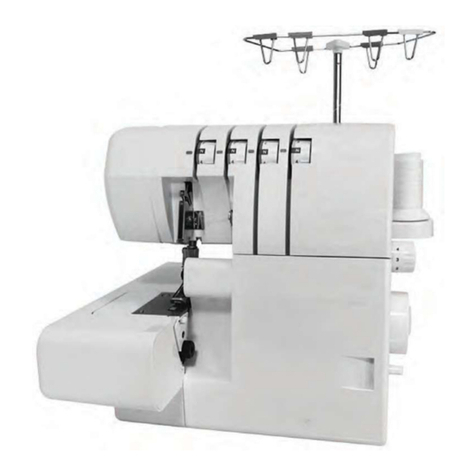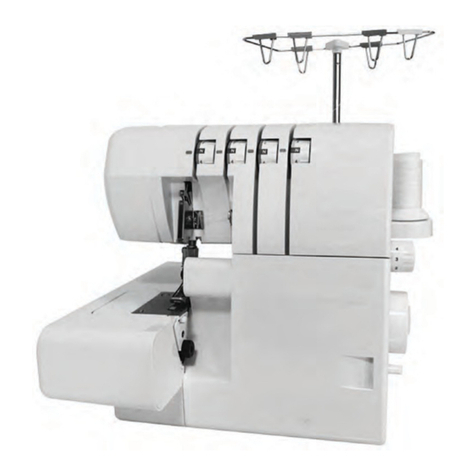Leader Like Me User manual


Important-Please read these instruction fully before starting assembly
Important Safety Instructions
When using an electrical appliance, basic safety precautions should always be followed, including the
following.
Read all instructions before using this sewing machine.
DANGER--To reduce the risk of electric shock:
1. Do not allow to be used as a toy. Close attention is necessary when this sewing machine is used
by or near children.
2. This appliance can be used by children aged from 8 years and above and persons with reduced
physical, sensory or mental capabilities or lack of experience and knowledge if they have been
given supervision or instruction concerning use of the appliance in a safe way and understand the
hazards involved. Children shall not play with the appliance. Cleaning and user maintenance
shall not be made by children without supervision.
3. Use this sewing machine only for its intended use as described in this manual. Use only
attachments recommended by the manufacturer as contained in this manual.
4. Never operate this sewing machine if it has a damaged cord or plug, if it is not working properly, if
it has been dropped or damaged, or dropped into water. Return the sewing machine to the nearest
authorized dealer or service center for examination,repair, electrical or mechanical adjustment.
5. Never operate the sewing machine with any air openings blocked. Keep ventilation openings of
the sewing machine and foot control free from the accumulation of lint, dust, and loose cloth.
6. Never drop or insert any object into any opening.
7. Do not use outdoors.
8. Do not operate where aerosol (spray) products are being used or where oxygen is being
administered.
9. To disconnect, turn switch to the off (”O”) position, then remove plug from outlet.
10. Do not unplug by pulling on cord. To unplug, grasp the plug, not the cord.
11. Keep fingers away from all moving parts. Special care is required around the sewing machine
needle.
12. Never sew with a damaged needle plate as this can cause needle to break.
13. Do not use bent needles.
14. Do not pull or push fabric while stitching. It may deflect the needle causing it to break.
15. Switch the sewing machine off (”O”) when making any adjustments in the needle area, such as
threading needle, changing needle, threading bobbin, or changing presser foot, etc.
16. Always unplug sewing machine from the electrical outlet when removing covers, lubricating, or
when making any other user servicing adjustments mentioned in the instruction manual.
17. Attention the following to avoid injury:
--switch off or unplug the appliance when leaving it unattended;
--unplug the appliance before carrying out maintenance.
Moving parts-To reduce risk of injury, switch off before servicing. Close
cover before operating machine.
This appliance complies with EMC Directive 2014/30/EU covering the
electromagnetic compatibility.
Please note that on disposal, this product must be safely recycled in accordance
with relevant National legislation relating to electrical/ electronic products. If in
doubt please contact your retailer for guidance.
CAUTION–
SAVE THESE INSTRUCTIONS
This product is for household use, or equivalent.

Know Your Machine
Name of parts............................................................................................................................2
Accessories...............................................................................................................................2
Preparing To Sew
Connecting machine to power supply ..........................................................................................3
Reverse sewing lever.................................................................................................................3
Sewing table .............................................................................................................................4
Presser foot arm ........................................................................................................................4
Changing the presser foot ..........................................................................................................5
Changing the needle..................................................................................................................6
Thread and needle chart.............................................................................................................7
Stitch selector and indicator........................................................................................................7
Bobbin winding..........................................................................................................................8
Threading the upper thread.........................................................................................................9
Threading the bobbin case........................................................................................................10
Drawing up the bobbin thread ...................................................................................................11
Seam guide line ......................................................................................................................11
Thread tension ........................................................................................................................12
Basic Sewing
Selecting stitch sewing.............................................................................................................13
Changing sewing directions......................................................................................................14
Reverse sewing.......................................................................................................................14
Basic Z-stitch ..........................................................................................................................15
Finish sewing ..........................................................................................................................16
Utility Sewing
Overlock stitches.....................................................................................................................17
Three-point Z-seam..................................................................................................................18
Blind seam..............................................................................................................................19
Decorative stitch......................................................................................................................20
Sewing buttonholes.............................................................................................................21-23
Care Of Your Machine
...........................................................................................................24-25 Cleaning shuttle race
Cleaning the feed dogs.............................................................................................................25
Oiling the machine....................................................................................................................26
Troubleshooting............................................................................................................................27
Specification................................................................................................................................28
Contents
1

Know Your Machine
2
Connecting the machine to
power supply
Name of parts
Accessories
1
2
3
4
5
6
7
8
9
10
11
12
13
14
15
16
17
18
19
20
21
22
23
24
Reverse sewing lever
Power switch
Machine socket
Handwheel
Bobbin winder stopper
Bobbin winder spindle
Spool pins
Carry handle
Stitch length adjustor
Thread guide
Bobbin winding thread
guide
Thread take-up lever
Thread tension dial
Face plate
Sewing table & accessory
box
Stitch selector dial
Thread cutter
Presser foot arm
Presser foot holder
Needle plate
Blind hem guide clamp
screw
Foot controller
Machine plug
Power supply plug
A
B
C
D
E
Bobbin 3 pcs
Ripper/Brush
Buttonhole foot
Needle set
Felt pads
22
23
24
E

3
ON
OFF
ON
OFF
Power/light
switch “ON”
Power/light
switch “OFF”
PreparingToSew
CAUTION: Ensure your fingers are
free from the needle and presser
foot area and do not press the Foot
Controller by mistake which
would automatically start the
sewing machine.
a:TurnoffthePowerSwitch.
b: Insert the Machine Plug into
theMachine Socket .
c: Insert the Power Supply Plug
intotheWallsocket.
d:TurnonthePowerSwitch to
turnonthepowerandthesewing
light will also automatically turn
on.
- Please read the important safety
instructions before use.
- Before connecting to the mains
make sure that the rated voltage
show on the rear panel matches
your mains voltage supply.
Press Reverse Stitch Lever
to start reverse sewing.
Reverse sewing lever
Connecting the machine to
power supply
Wall socket
Table of contents
Other Leader Sewing Machine manuals



















